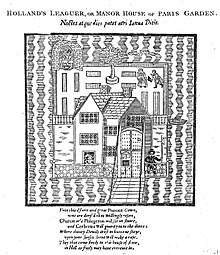Holland's Leguer

Holland's Leguer was the name of a Dutch English brothel in London between 1603 and January 1632. It has been referred to as the most famed brothel in 17th-century England. "Legeur" means military encampment.[1]
Holland's Leguer is described as a manor house in Old Paris Garden, Southwark, by the Thames, surrounded by a moat with a bridge and bars. It was an expensive establishment with king James I of England and George Villiers, 1st Duke of Buckingham, among its clients. The brothel was owned and managed by Elizabeth "Bess" Holland.
In December 1631, Charles I of England gave order of its closure and sent soldiers there to perform the order. Bess Holland raised the bridge over the moat, causing the soldiers to fall in the water, after which the brothel workers emptied their pots over them. The brothel was besieged for a month until it was finally closed in January 1632.
The siege of Holland's Leguer was portrayed in the pamphlet Holland's Leaguer by Nicholas Goodman, the play Holland's Leaguer by Shackerley Marmion, and the ballad "News from Holland's Leaguer" by Lawrence Price.
References
- ↑ Higgins, Siobhán. "Britain's Bourse: cultural and literary exchanges between England and the Low Countries in the early modern era (c. 1580-1620)" (PDF). Cork Open research Archive. University College Cork. Retrieved 29 April 2018.
- Melissa Hope Ditmore, Encyclopedia of Prostitution and Sex Work: A–N. Vol. 1